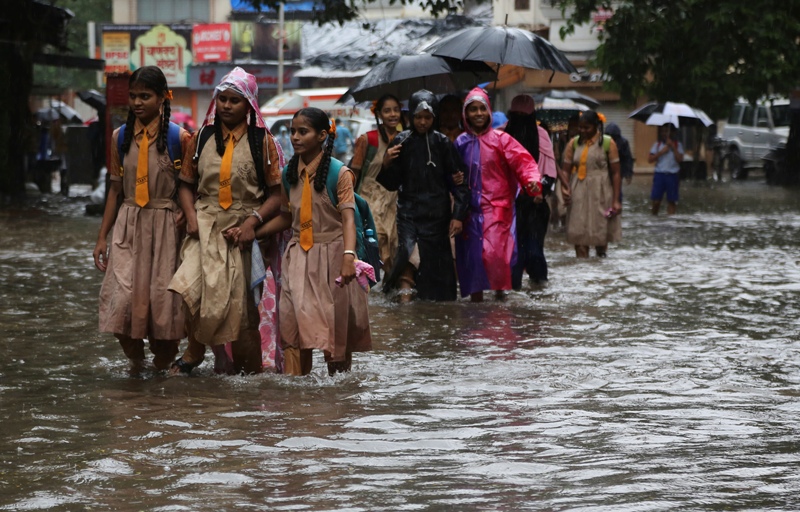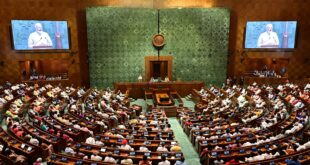 India’s western coastal states of Maharashtra and Goa along with the Himalayan region of Himachal Pradesh and Uttarakhand have witnessed a spate of extreme weather events. Hundreds of people have lost their lives owing to deadly floods, cloud bursts and landslides.
India’s western coastal states of Maharashtra and Goa along with the Himalayan region of Himachal Pradesh and Uttarakhand have witnessed a spate of extreme weather events. Hundreds of people have lost their lives owing to deadly floods, cloud bursts and landslides.
Tens of thousands of people have been evacuated since July 22, with record-breaking rainfall reported along parts of the Western coast. According to the Relief and Rehabilitation Department – Maharashtra, about 229,074 people have been evacuated from the flood-hit areas. A total of 164 deaths have been reported till July 26 and 25,564 animals have died. 56 people were injured and 100 are still missing. A total of 1028 villages have been affected, out of which Raigad district is worst affected, followed by Ratnagiri and Satara districts.
Meanwhile, Himachal Pradesh reported a landslide on July 25, killing 9 and leaving several injured. Uttarakhand has been reporting a series of landslides ever since the beginning of the month.
Experts say that it’s high time we accept that the impact of climate change is now visible on our daily lives. With global warming intensifying, Indian Monsoon season has become erratic. Scientists have already warned that Monsoon rains would increase further with increase in global temperatures.
“Not even halfway through the season and we have already achieved the seasonal rainfall target. Climate change is the reality of the moment. Weather sensitivities are on the rise, be it the intensity or frequency of cloud burst, landslides, heavy rainfall, cyclones or other phenomenon. Monsoon has become erratic and we are witnessing a sea change in the Monsoon season pattern which was once considered to be the most stable. It is no longer a domain of weather experts and requires a multidisciplinary or multi-specialty focus, which needs integration among all the stakeholders,” said AVM G P Sharma, President – Meteorology and Climate Change, Skymet Weather.
According to a recent study by Potsdam Institute for Climate Impact Research, ‘‘Climate change is making Indian monsoon seasons more chaotic, for every degree Celsius of warming, monsoon rainfalls will likely increase by about 5%. Global warming is increasing monsoon rainfall in India even more than previously thought. It is dominating the monsoon dynamics of the 21st century.
Climate change is leading to unpredictable weather extremes and their serious consequences. What is really on the line is the socio-economic well-being of the Indian subcontinent. A more chaotic monsoon season poses a threat to the agriculture and economy in the region and should be a wakeup call for policy makers to drastically cut greenhouse gas emissions worldwide.
Mahesh Palawat, Vice President – Meteorology and Climate Change, Skymet Weather added, “July is the rainiest month for the four-month long Southwest Monsoon season. With vigorous Monsoon conditions prevailing over the country, we were expecting heavy rains across Maharashtra, but the series of extreme weather conditions were not expected. There is no doubt that we are in the thick of climate change and the results are in front of us. Deforestation and rapid urbanization coupled with the fragile nature of Western Ghats led to landslides and massive destruction. Warming of atmosphere increases the capacity of air to hold moisture, which leads to formation of intense cumulonimbus clouds or vertically developed clouds, bringing some incessant downpour over the region. Besides, when the atmosphere is unstable, these clouds keep regenerating and this turns into a series of cloud development triggering incessant rainfall.”
Talking about the weather patterns in the Himalayan region, Palawat further said, “Weather becomes more sensitive in the hilly region, as mountains respond to weather more quickly. As reiterated earlier, with the development of cumulonimbus clouds in the absence of strong upper air winds, they do not tend to travel very long or we can say they are trapped. These clouds then deplete all the water over a certain area which is called cloud burst. Deforestation and continued construction of hydropower plants, roads, hotels or homes have led to loosening of soil, resulting in frequent landslides even with the slightest of rains. Also, our Himalayan ranges are ecologically friable, the smallest impact of climate change can lead to fatal events in mountainous terrains.”

The IPCC’s fifth Assessment Report cycle concluded that human influence on the climate system is “clear”. Since then, literature on attribution – the sub-field of climate science that looks at how (and by how much) human activities lead to climate change – has significantly expanded. Today, scientists are more certain than ever that climate change is caused by us. A recent study finds that humans have caused all of the warming observed since the preindustrial period, leaving no room for debate as to why the climate is changing. Since AR5, there has also been an increased focus on regional impacts, with scientists improving their models and understanding of what global climate change impacts will look like on a regional scale.
Cost of inaction is higher without building climate resilience
India, one of the world’s fastest growing economies with over a billion population, is at the brink of grave consequences if global warming and climate change continue to go unchecked. Apart from natural disasters, the economic cost of these disasters is pinching a developing economy even more. With various studies predicting more extremely wet years, the threat looms large over people’s well-being, economy, agriculture and food system.
There has been consensus among the communities of environmentalists, scientists and other related stakeholders to develop and implement action plans at several stages involving communities on ground before it is too late. “We are experiencing these extreme weather events not only in India but in parts of Europe and China as well. We have been seeing horrific images of devastation in China and Germany, which show that climate change is here and now. It is no longer a developing country’s problem alone, but it is now hitting the industrialized nations such as Germany, Belgium, and The Netherlands.
IPCC scientists have been warning about these issues since the past couple of years. The latest IPCC report on Oceans and Cryosphere (SROCC) gives us a detailed account of how global warming is leading to a warming up of oceans and how the monsoon patterns are changing rapidly. The Indian subcontinent’s monsoon system has drastically changed due to global warming. You either have a long spell of drought or heavy downpour.
Also Read : China’s counter sanction upon US officials
Also Read : Sydney extends lockdown for people
This is going to be the new normal. Indian cities, towns and villages need urgent plans for adaptation. A special focus must be on building climate resilient infrastructure and risk management plans as these growing extreme events will impact lives as well as our economies. Secondly, India should lead the global south in galvanizing countries towards a green growth model and to keep the planet’s temperature below 1.5 degree Celsius. It is possible to balance between, people, profit, and the planet,” said Dr Anjal Prakash, Research Director and Adjunct Associate Professor, Bharti Institute of Public Policy, Indian School of Business and lead author in the 6th Assessment report of IPCC.
 Jubilee Post News & Views
Jubilee Post News & Views





